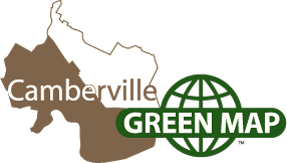Is the data used to make the map available?
Much of the data used to make the map is from public sources, although it
has since undergone extensive processing. In the future, we'd like to release
what we can, however we are under-staffed and curently focused on setting up a
proper web map service and distributing the paper maps. If you'd like to help
out with these or other tasks, please feel free to
contact us.
Why did/didn't you include … on the map?
It's possible we don't know about your favorite feature,
tell us. There are also many features that we could
not fit onto the paper/PDF version of the map. The upcoming web map will
include everything we know about, as well a variety of other related
information.
We had to make many choices regarding what was and was not shown on the map,
below you'll find explanations about some of these decisions. See also
Cambridge Greenmap - Experimental Design,
Selection and Classification in "Improving the Cartographic Quality and
Design of Greenmaps."
Backyard Habitat
- The National Wildlife Federation runs the
Backyard Habitat program to promote
wildlife friendly landscaping. We elected to highlight these
features—despite their being relatively few in the area—since the
NWF gave us our first grant, and because we like the idea of promoting urban
wildlife and native planting.
Dry Cleaners
- Conventional dry-cleaning uses hazardous petro-chemicals like
"perc", however, in recent years a number
of "environmentally friendly" alternatives have become available. The Cambridge
Greenmap only includes cleaners using one of these technologies, supercritical
CO2. Details behind this decision are coming soon.
Vegetarian Restaurants
- We did not include Chinese and Indian restaurants in the list, as we feel
that they are fairly obvious dining options, and their inclusion would have
simply cluttered the map.
What is/are … ?
Potential Vernal Pools
- The
Natural Heritage & Endangered Species Program
documents the locations of several types of habitat, including vernals pools.
Vernal pools are an
important habitat
or amphibians and other wildlife, and PVPs are sites that share many of the
characteristics of vernal pools, but have not yet been verified as suitable
habitats.
Rare Species
- The Division of Fisheries and Wildlife maintains a list of known rare
species sitings by town. View the Cambridge rare species list. Note:
However, many rare species are difficult to detect even though they are present, and Natural Heritage does not conduct methodical species surveys in each town on a consistent basis. Therefore, the fact that the 'Most Recent Obs' for a species may be several years old should not lead to the interpretation that the species no longer occurs in a town.
Contact Us
Green Map Logo © 2003 Green Map System, Inc.

